
The sand leek, also known as rocambole and Korean pickled-peel garlic, is a Eurasian species of wild onion with a native range extending across much of Europe, Middle East, and Korea. The species should not be confused with rocambole garlic, which is A. sativum var. ophioscorodon.
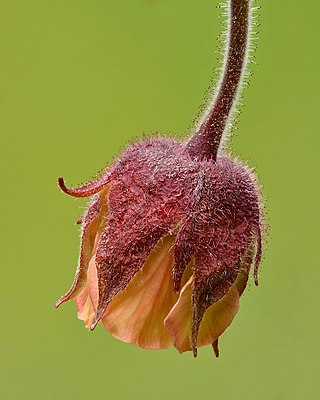
Geum rivale, the water avens, is a flowering plant in the genus Geum within the family Rosaceae. Other names of the plant are nodding avens, drooping avens, cure-all, water flower and Indian chocolate. It is native to the temperate regions of Europe, Central Asia and parts of North America, where it is known as the purple avens. It grows in bogs and damp meadows, and produces nodding red flowers from May to September.

Alyssum is a genus of over a hundred species of flowering plants in the family Brassicaceae, native to Europe, Asia, and northern Africa, with the highest species diversity in the Mediterranean region. The genus comprises annual and perennial herbaceous plants or (rarely) small shrubs, growing to 10–100 cm tall, with oblong-oval leaves. Alyssum flowers are characteristically small and grouped in terminal clusters; they are often yellow or white colored but can be pink or purple.
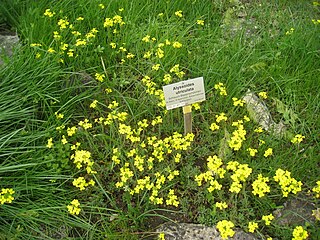
Alyssoides is a genus of flowering plants in the family Brassicaceae containing a single species, Alyssoides utriculata. A herbaceous perennial plant native to Southern Europe and Turkey, it grows on dry rocky slopes and on calcareous rocks, reaching heights of 20 to 50 cm and blooming with yellow flowers between April and May–July.

Roemeria argemone is a species of flowering plant in the poppy family Papaveraceae. Its common names include long pricklyhead poppy, prickly poppy and pale poppy. Its native range includes parts of Eurasia and North Africa, but it can be found growing wild in parts of North America, where it is an introduced species. It is cultivated as an ornamental plant.

Diplotaxis tenuifolia is a species of flowering plant in the mustard family known by the common name perennial wall-rocket. It is native to Europe and West Asia, where it grows on disturbed ground and roadsides, and it can now be found throughout much of the temperate world where it has naturalized. In recent years it has increasingly been cultivated to produce salad leaves, which are marketed as wild rocket in Britain or arugula in the US. It is easily confused with garden rocket, which has similar uses.
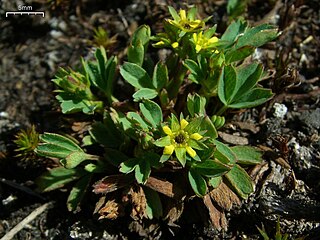
Sibbaldia procumbens is a species of flowering plant of the genus Sibbaldia in the rose family. It has an Arctic–alpine distribution; it can be found throughout the Arctic, as well as at higher elevations in the mountains of Eurasia and North America. It grows on tundra and in alpine climates where snow remains year-round, and on subalpine mountain slopes. This is a low, mat-forming perennial herb producing clumps of herbage in rocky, gravelly substrate. A spreading stem up to 15 centimeters long grows from a caudex. Each leaf is divided into usually three leaflets borne at the end of a petiole up to 7 centimeters long. Each wedge-shaped leaflet has three teeth at the tip. The flower has usually five pointed green bractlets, five wider pointed green sepals, and five tiny yellowish petals each about a millimeter long. The fruits develop in the remnants of the sepals on erect stalks.

Geum coccineum is a species of flowering plant in the genus Geum, in the rose family Rosaceae. Native to the mountains of the Balkans and northern Turkey, it is also grown ornamentally for its bright red flowers.
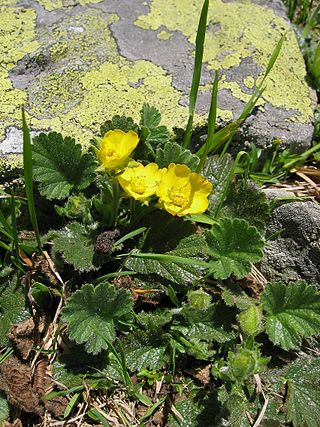
Geum montanum, the Alpine avens, is a species of flowering plant of the genus Geum in the Rosaceae family, native to the mountains of central and southern Europe.
Arvo Jaakko Juhani Jalas was a Finnish botanist. He worked in the University of Helsinki.

Illecebrum is a monotypic genus in the family Caryophyllaceae. It contains the single species Illecebrum verticillatum, which is a trailing annual plant native to Europe, with whorls of small white flowers borne in the axils of the paired leaves.

P. Arne K. Strid is a Swedish botanist and expert on Greek flora.

Rosa tomentosa, otherwise known as the harsh downy-rose, is a species of wild rose. It is a shrub growing to about 3 metres (10 ft). It is found in Asia Minor, the Caucasus, and much of Europe: the British Isles, France, Central Europe, northern Spain, Italy, and the Balkans . On the British Isles it can be found in hedgerows and woodland margins, and it typically flowers between June and July. Further south, in Bulgaria, it flowers in May.
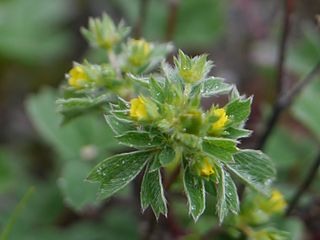
Sibbaldia parviflora is a species of flowering plant in the genus Sibbaldia of the family Rosaceae, native to Southeast Europe and West Asia. It is a herbaceous perennial plant growing in damp rocky places on alpine meadows.
Geum molle is a species of flowering plant of the genus Geum (avens) in the family Rosaceae. A perennial herbaceous plant found on meadows, it is native to the mountains of the Balkan Peninsula and Italy. It blooms with yellow flowers between June and August.
Geum borisii may refer to the following plants of the genus Geum:
Alyssum pulvinare is a species of madwort, a flowering plant in the family Brassicaceae. A perennial herbaceous plant native to the Balkans, it grows on rocky places, rock ledges and dry grassy slopes, forming tufts about 6–15 cm high. It flowers in May and June.
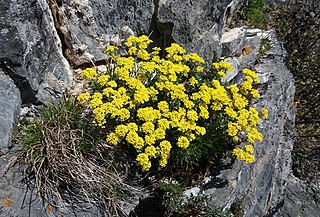
Odontarrhena is a large genus of flowering plants in the family Brassicaceae. They were originally a separate genus and then were amalgamated into the Alyssum genus, but then morphological and molecular evidence has reseperated them. Some of the genera are nickel (Ni) hyperaccumulators.
Lutzia cretica is a species of herbaceous plant endemic to the Aegean Islands of Greece. It is the only species in the genus Lutzia, which belongs to the cabbage family Brassicaceae.













